I first met Rhiannon Lewis in 2015, at the AIA conference in Denver, Colorado. We were briefly introduced, had a lovely chat in English and French, and she mentioned two conferences she “has her fingers in” – Phyt’Arom in Grasse, France, and Botanica. If you’ve ever met Rhiannon, you know how charming she is, which in turn makes you want to take part in everything she is involved with. Well, Robert Tisserand and I did attend Phyt’Arom in October 2017 (see post here), and really loved the conference. And so we planned to attend Botanica in September 2018, and it was as inspiring and energizing as advertised!
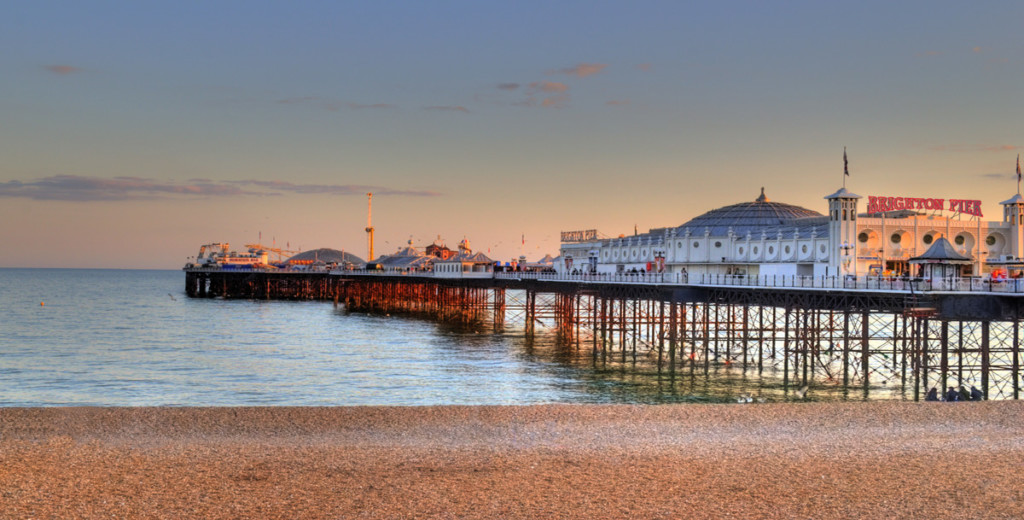
Due to a chain of events, Robert ended up also speaking at the event, which gave us the opportunity to experience the ‘backstage’ as well. We did not take part in the pre-conference workshops, or the post-conference study tour. And although we tried, we did not manage to hear all of the speakers. I am, however, very much looking forward to going through the proceedings of the conference to discover any ideas that I might have missed. The complete line-up of presenters can be seen here. Below is a report on what Botanica2018 brought for us, as well as for the whole field of aromatherapy and plant medicine.
Bringing together ‘plant folk’ from all over
Much like Phyt’Arom, Botani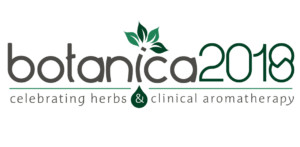 ca is not only focused on aromatherapy and essential oils, but brings together many practitioners of plant-based medicine – herbalists, aromatherapists and naturopaths alike. It also brings speakers, and audiences, from all over the world. This, in turn, gives attendees a truly global perspective, as well as inspiration from others. And it’s not just about listening to presentations, there are many networking opportunities, from the trade show presentations to the gala evening. How often do you sit at the same table with aromatherapists from the USA, UK, Hong Kong, Singapore, Syria and the Czech Republic?
ca is not only focused on aromatherapy and essential oils, but brings together many practitioners of plant-based medicine – herbalists, aromatherapists and naturopaths alike. It also brings speakers, and audiences, from all over the world. This, in turn, gives attendees a truly global perspective, as well as inspiration from others. And it’s not just about listening to presentations, there are many networking opportunities, from the trade show presentations to the gala evening. How often do you sit at the same table with aromatherapists from the USA, UK, Hong Kong, Singapore, Syria and the Czech Republic?
As for the presentations, I saw three distinct threads: 1) A thought-provoking look at possible ways to bridge the past experience with the new research; 2) Harvesting, processing and distribution of raw materials; 2) Practical uses and applications. Each brought many interesting points, and I will now try to interpret them as best I can.
Where past experience meets new research: the crossroads for holistic healing
With new research in alternative, herbal and essential oil-based medicine emerging every day, the community needs to find a way to reconcile its experiential-based past with the scientific present, to create a truly “holistic” future. That, in a nutshell, was the philosophical message of the conference. The opening talk of the conference, given by the brilliant Holly Bellebuono, tackled the nature of healing itself, in an invitation for a self-reflection of the whole field. At a time when essential oil-using practitioners have to fight the prejudice of the medical field as well as the marketing hype built around aromatherapy, such reflection is indeed timely.
Danny O’Rawe presented a truly philosophical perspective on the topic, finding the common ground between science and tradition and recognizing that the usual scientific rigor and research geared towards single-chemical drugs may not be suitable for plant-based medicine. However, it is worth noting that both WHO and the FDA recognize research done on multi-constituent preparations, such as essential oils and herbs, as long as their composition can be standardized. In his talk on Cancer and Cannabis, Jonathan Treasure also mentioned the need to combine the purely experiential herbalism of the past (the “let’s see what works” approach) with the sometimes narrowly focused scientific approach that is emerging (“let’s see exactly why it works”) into a more holistic paradigm where both practical experience and scientific discoveries have a place at the table.
So how do we integrate the long history of practical, hands-on experience and wisdom of healers and aromatherapists with the rigor of scientific questioning? Can essential oils and herbs be put in neat categories and matched with ailments, in the same way as allopathic medicines? I would argue that, if we take a holistic approach, then “this-for-that” medicine is an over-simplistic answer.
Hopefully, the whole field of plant-based medicine can move to a place where we consider all of the evidence, whether coming from practitioners or the research community. Let’s see if we are able to establish a functioning link between the two worlds – wouldn’t it be great to have researchers look at the areas aromatherapists are most interested in, and on the other hand have aromatherapists verify in real life the tentative findings of the research? This, in my opinion, is the way to evolve into a field that is fully backed by reality, whether that reality is observed by a healer, by a clinician in a clinical study, or by a biologist looking in a petri dish. Such an approach will indeed help us see the whole picture, and find the most suitable tools to help heal those who come to us seeking wellness. I was delighted to see that the lineup of the Botanica 2018 conference offered exactly this kind of overall picture.
Raw materials: environmental and economic sustainability
Botanica2018 brought together people involved in all phases of the process of procuring raw materials – herbs and essential oils – from growers, to distillers, and finally, traders. The message of sustainability was loud and clear, as was that of social responsibility. All three of the distillers who presented on Friday, representing their businesses in Italy (Marco Valussi of Gadoi), the USA (Judson Carleton of Morning Myst Botanics) and Pakistan (Saad Admani of Moonstar Admani), stressed the importance of involving local communities in the production process, even though this can be a tough sell at times. All three are trying to revive rural areas that are troubled by an outflow of young people who seek better work opportunities in the cities, as well as by lack of stewardship of the land. On top of employing and involving local communities, Moonstar Admani also supports local schools and the education of girls, in a commendable effort to level the playing field in Pakistan.
What I found quite unique was the unashamed mention of economic sustainability. Unless you reach the right market, work with the customers, wholesalers and the larger aromatherapy community, you may be producing what you believe to be the greatest oil the world has ever seen, but things might still not work out financially. This was especially poignant in Marco Valussi’s presentation, which was refreshingly down to earth in terms of comparing initial plans with harsh reality. As in any business, being flexible and changing your plans if they no longer make sense is crucial (although detailed plans and vision are equally important).
But besides the human and landscape costs, sustainability is about the renewal of the resources used, perhaps even more acutely. As Marco said: “Distillation is an expensive business for the plant”. This was the focus of Zahra Osman’s presentation on frankincense trees in Somaliland, and the challenges faced there with the increased popularity of Frankincense essential oil.
Using essential oils from plants that grow locally to you – wherever you live – is a good way to preserve resources, and sometimes even to discover new fragrant medicines, as was the case with Greg Trevena’s Australian Rose. His Essentially Australia is focused on the production of essential oils from plants native to Australia, and introducing new plants to the aromatherapy world in the process.
But how do we know what to use a new essential oil for, when there is no existing research or clinical experience? This is where analysis and chemistry can help. Knowing what constituents are found in an essential oil – or hydrosol or CO2 extract – is key to understanding its therapeutic potential (and safety concerns), and this is especially true for newly discovered materials. Hubert Marceau of Phytochemia presented their elaborate view on the possibilities to accurately analyze hydrosols, aromatherapy tools we are bound to hear more and more about in the near future, as they regain some of the fame they enjoyed in the past. And for more overarching information on essential oil composition and potential benefits, Dropsmith’s Melani Kovac offered the first peek into what has the ambition to become an extremely valuable information resource. There is still some way to go, but Melani has a unique perspective as well as the support of many in the field, and so hopefully Dropsmith will grow to fulfill its founders’ vision.
On top of the excellent presentations, the production side of aromatherapy was given plenty of space in the trade show. A whole room was dedicated to distillers, who were more than happy to talk about different distillation techniques and present their deliciously smelling products.
From theory to practice: where essential oils help
The following is a summary of the talks that gave insights into the practice of aromatic and plant medicine, from the importance of a healthy gut microbiome, to the links between our nose and our brain (and our gut, interestingly), and to the support essential oils can bring to oncology patients. This is a “distilled” version of what were incredibly enlightening talks.
Many presenters brought hopeful messages of how essential oils and herbs help if not to completely heal, then at least improve the life quality of various groups. Slobodanka Postic, a Croatia-based natural perfumer, surveyed the participants of her perfume making workshops to see a tangible effect of wearing a natural fragrance. Robert Thomas, an oncologist from the UK, came as a rare ambassador of the medical profession – to herald the ability of essential oil preparation to prevent nail damage in chemotherapy patients. He presented the very impressive results of a clinical trial he co-authored, and which was published in Breast Cancer Research and Treatment. And many presenters brought new visions of practical applications of herbal and aromatic medicines.
Trust your gut
Three presenters focused on plant medicine in relation to our gut. Luc Marlier tackled the intriguing prospect of fragrance influencing our food choices. The research in this area is in early stages, but the premise that low intensity fragrance may help us make healthier food choices is not just fanciful. As well as our brain telling us how to keep our gut happy, it seems to work the other way. We know that the gut microbiome is crucial for the health of our digestive system, and we are beginning to discover that it might be also important for our mental health. James Keane addressed the importance of gut bacteria diversity in the neurological development of children, as well as the prospect of being able to tackle mental issues with targeted care of the gut-brain axis.
Jason Hawrelak, a New Zealand based herbalist whose practice is focused on restoring the gut microbiome, presented his investigation into how herbal preparations influence our own bacteria. It has been suspected, but not yet investigated, that if a substance is effective in killing the “bad bugs”, it may not exactly be beneficial for the good ones either. Jason conducted a series of in vitro studies using several herbal preparations and essential oils. He found that while some are selective in their killing punch, eliminating pathogenic bacteria at lower concentrations while sparing commensal colonies, a few were equally effective in wiping out both groups. One such “kill-all” was oregano oil. As Jason pointed out, this is not necessarily a good or a bad thing, it just means we have to consider it when selecting the most appropriate treatment.
Inhalation for mental health, and radiant skin
It seems that under the host of new potential applications of essential oils, we sometimes forget about the easiest, safest and – as we will see – sometimes the most efficient method of use – inhalation. Nick Singer from Switzerland talked about the practical use of aroma inhalers (personal inhalers, inhaler sticks) and the results seen in researching their effect on psychological and physiological parameters. He stressed the difference in intensity of effect between aroma inhalers and diffusion. ‘Aroma-therapy’ still has a lot to say, it seems.
But how about those who cannot benefit from the aromatic component of essential oils? Christine Kelly has been working on smell training for people who have lost their sense of smell, and both her work and the research lead by Thomas Hummel in Germany bring some hope to anosmics. This is a topic I am personally very familiar with – stay tuned for a detailed article on anosmia and olfactory training.
To bring the importance of dosed inhalation close to home, Robert Tisserand presented a novel idea combining lab research with clinical experience. First, he explained that there is cross-talk between the brain and the skin. For example, smelling Rose oil is not only calming, but can also improve the barrier function of your skin, while applying Rose oil to your skin also induces relaxation, even if you are not inhaling it. This could have broad implications for several skin and brain conditions, that can be addressed with the use of the same essential oils, because of interaction with the same targets. Robert looked at the use of Sandalwood oil and its interaction with the enzyme PDE4 and Copaiba oil and the interaction of its major constituent beta-caryophyllene with CB2 receptors. Combining lab research with clinical data we can see why these essential oils are therapeutic for some psoriasis patients, and their mechanisms of action suggest further uses, such as Parkinson’s disease. Finally, Robert demonstrated the importance of the nose-to-brain route for impacting neurological disease, and the significance of ‘ectopic’ olfactory receptors – those that are found outside the olfactory system, and that are also functional.
Uncommon Scents: reflecting back on the community
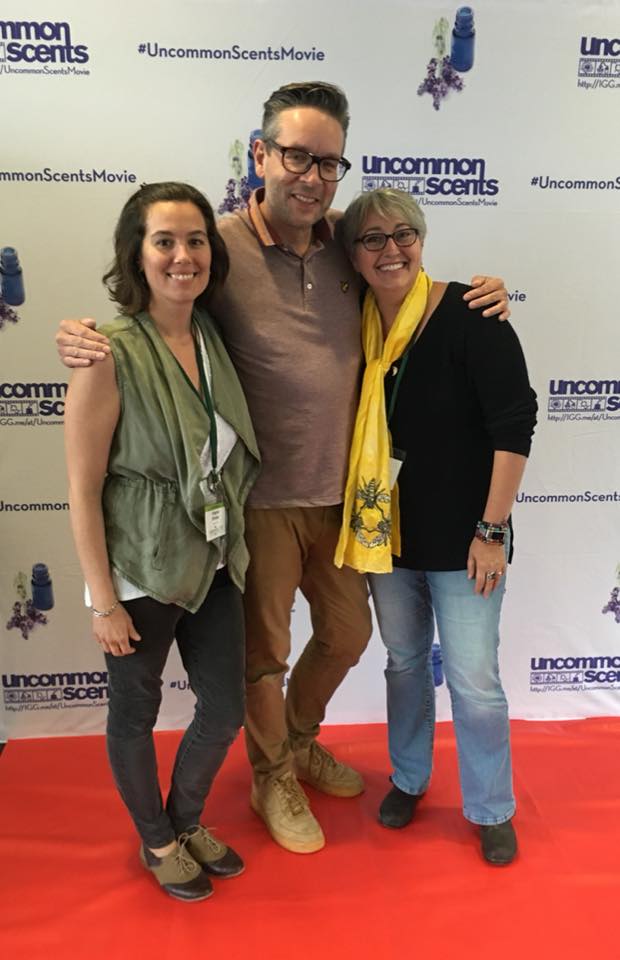
Angela Ehmke, Pierre Thiebaut and Kristina Bauer, the Uncommon Scents team
My report on the conference would not be complete if I omitted the fact that we were treated to a special preview teaser of the upcoming Uncommon Scents documentary. Kristina Bauer and Angela Ehmke have spent a better part of the last three years collecting unique views on essential oils and aromatherapy, from within and without the community. The film is nearer and nearer to being finished, and from what we saw, it promises to give and incredibly comprehensive look at who we, the “essential oil people”, are. You can be a part of the picture, by supporting their crowdfunding campaign here.
Conclusion
I really enjoy going to industry events such as Botanica, for perspective, inspiration and connection. Whatever it is that you do in relation to essential oils, it is always a good idea to look at what others are doing, and to see if perhaps you need to adjust your approach, or to confirm that you are on the right path. Whenever you are struggling to find motivation, a conference can provide a much-needed injection of new zeal and inspiration. And whoever you are, making real life connections with people you may know only from the digital world, is invaluable. For me personally, it was a delight to meet the many Tisserand Institute students who came to say hi. We don’t know yet where the Botanica2020 conference will be, but I am already looking forward to meeting many of you there!
The conference proceedings of Botanica2018 will be available later in 2018.

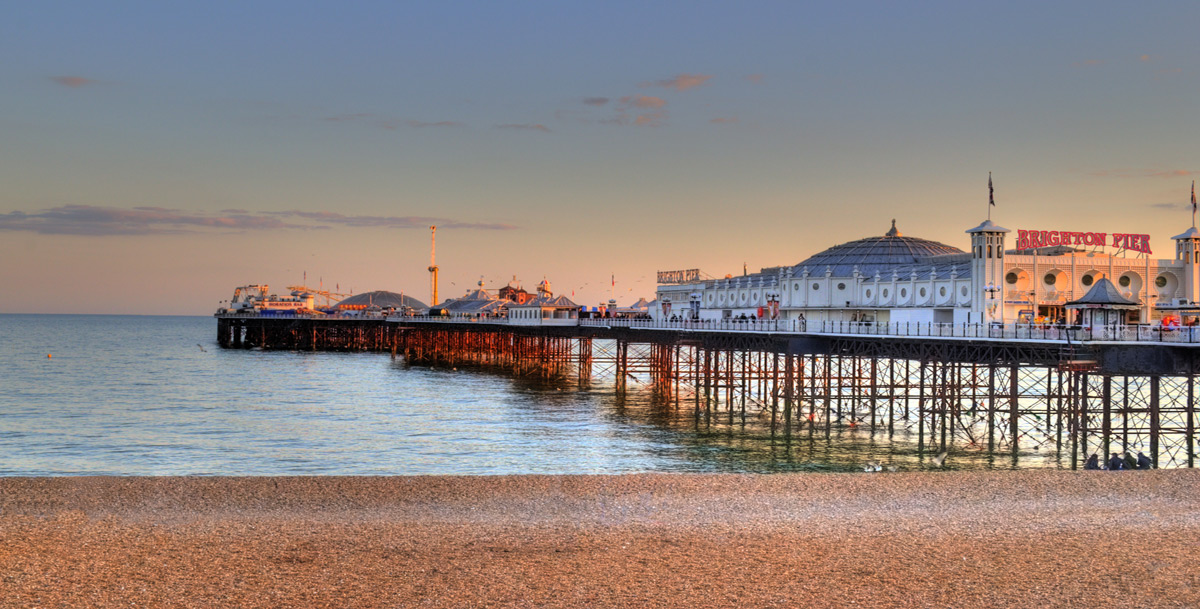
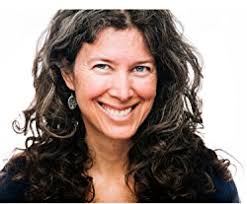
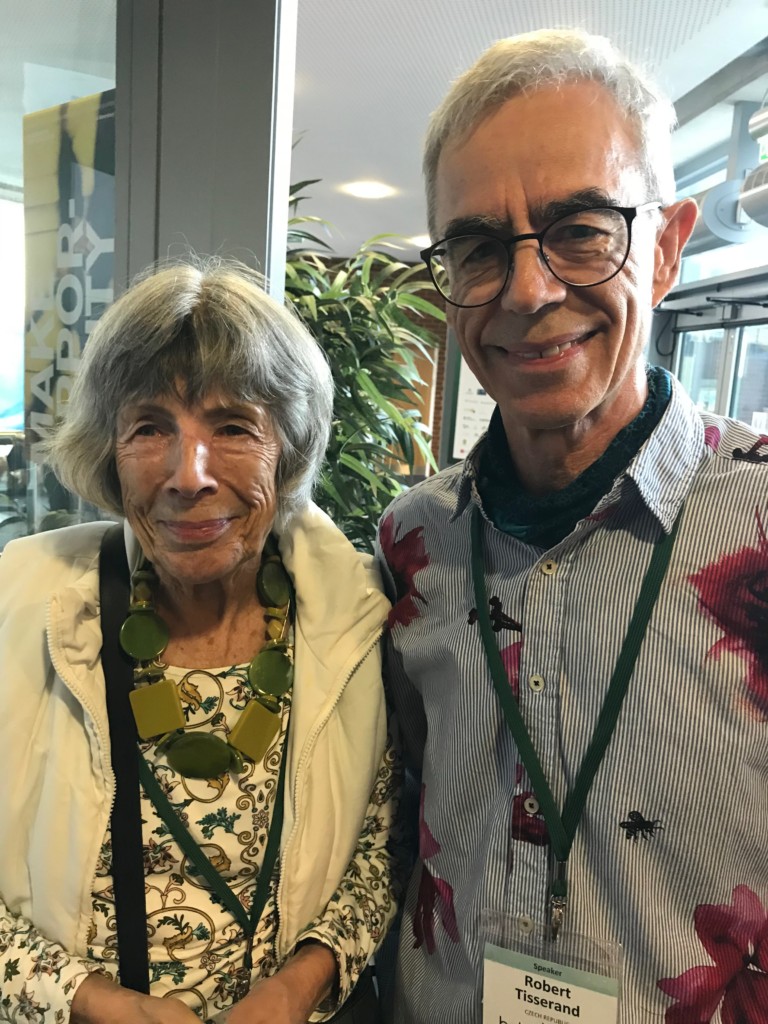
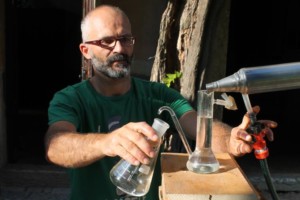
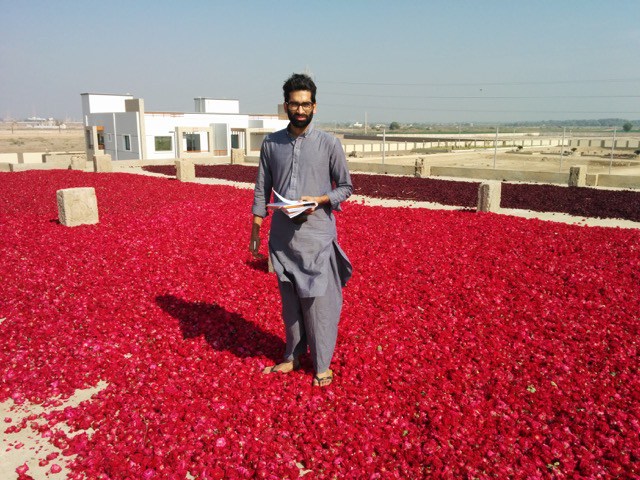
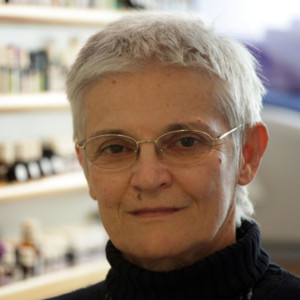
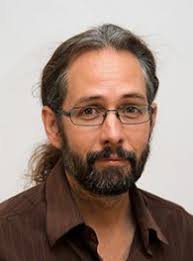
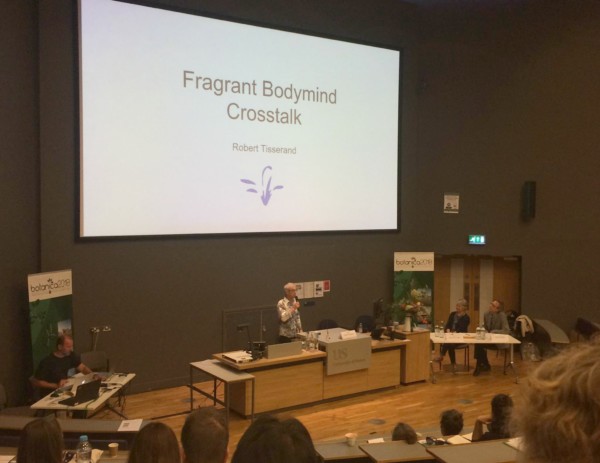
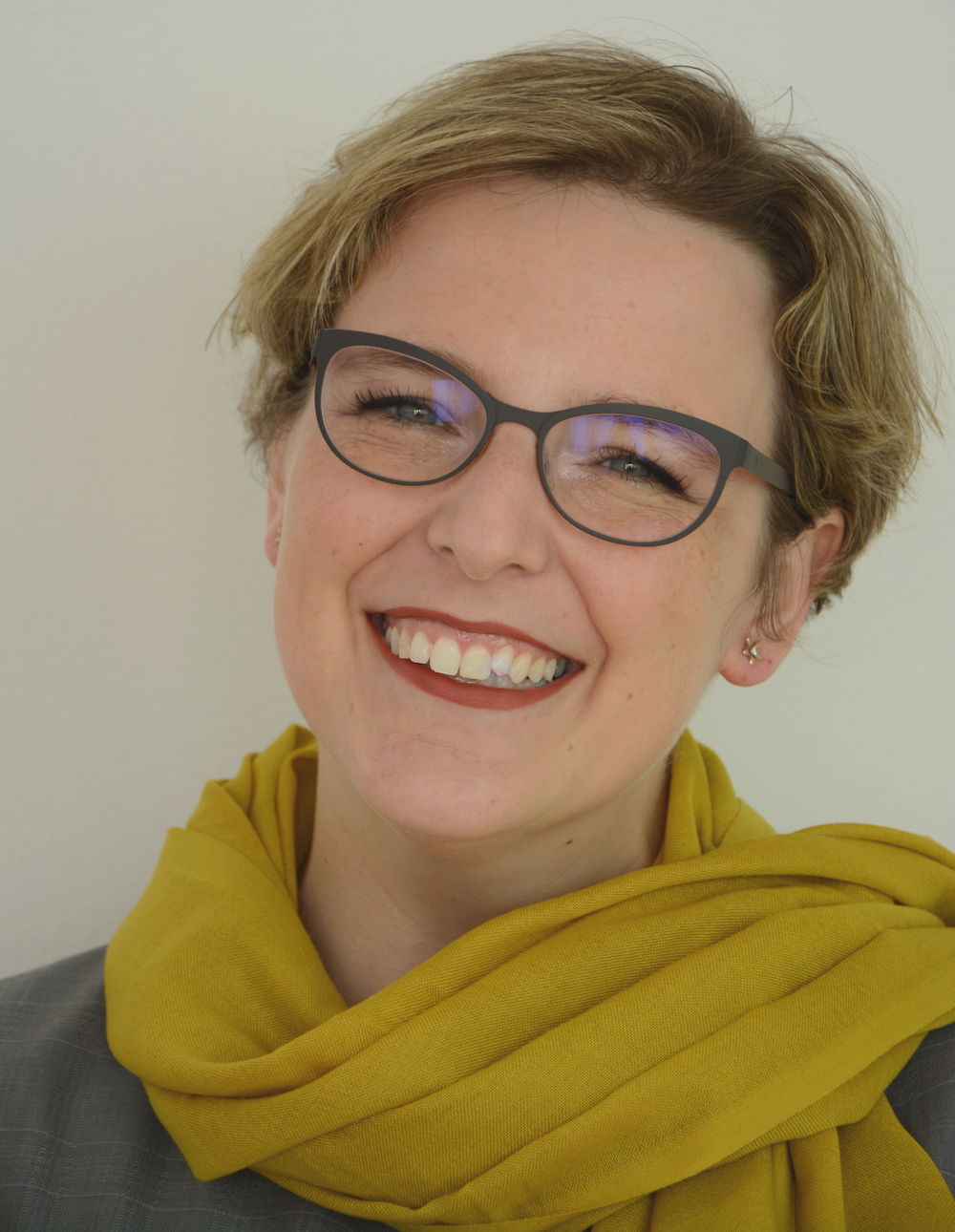
Outstanding, Hana
Excellent article. Intriguing snippets that want me to discover more. Leaving me with the feeling that things are looking good for the industry. And yes, I’ll be at Botanica2020!
Well done Hanna! your writing and describing things were clear. I heard hope and opportunities in aromatherapy’s future, thank you.